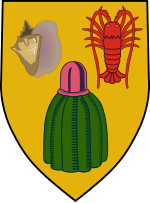| This article's factual accuracy is disputed. Relevant discussion may be found on the talk page. Please help to ensure that disputed statements are reliably sourced. (July 2021) (Learn how and when to remove this message) |
| Coat of arms of the Turks and Caicos Islands | |
|---|---|
 | |
| Versions | |
 Lesser variant Lesser variant | |
| Armiger | Turks and Caicos Islands |
| Adopted | 28 September 1965 (1965-09-28) |
| Crest | On a Wreath Or and Azure, On a Mount Vert a Pelican between two Sisal Plants proper |
| Shield | Or in chief a Queen Conch Shell and a Spiny Lobster and in base a Turk's Head Cactus proper |
The coat of arms of the Turks and Caicos Islands consists of a gold-coloured escutcheon (shield) charged with a conch shell, lobster and a cactus, supported by two flamingos, and topped with a pelican in the crest. Adopted three years after the islands became a Crown colony, it has been the coat of arms of the Turks and Caicos Islands since 1965. The escutcheon is featured on the flag of the territory. The previous badge featured two mounds of salt in front of a ship, with doors added to the mounds after they were reportedly mistaken for igloos.
History

The Turks and Caicos Islands were ruled by the British colonial government in the Bahama Islands starting in 1799. Tensions between the two territories, coupled with financial troubles, led to the Turks and Caicos being given their own charter in 1848, before being placed under the administration of the Colony of Jamaica 26 years later. During the 1870s, the territory was accorded its own badge to be utilised on its flag. This consisted of two mounds of salt on land in the foreground, awaiting to be loaded onto a ship in the background. A door was erroneously added to one of the mounds, however, when the designer or an official at the Admiralty reportedly mistook the salt mounds for igloos. This was not rectified up until a new coat of arms was instituted in the 1960s.
The Turks and Caicos Islands became a Crown colony in 1962, after Jamaica became independent that same year. The islands were consequently reunited with the Bahamas from 1962 until 1973, when the latter territory became independent and the Turks and Caicos were granted their own governor. A new coat of arms for the territory was adopted by royal warrant on 28 September 1965.
Design
The coat of arms of the Turks and Caicos Islands are blazoned as follows:
Or in chief a Queen Conch Shell and a Spiny Lobster and in base a Turk's Head Cactus proper; and for the Crest: On a Wreath Or and Azure, On a Mount Vert a Pelican between two Sisal Plants proper; and for Supporters: On either side a Flamingo proper.
Symbolism
The colours and objects on the coat of arms carry cultural, political, and regional meanings. The queen conch shell and spiny lobster allude to the islands' primary industry of fishing. The Turk's Head cactus symbolises the territory's biome. Taken altogether, the shell, lobster, and cactus represent the flora and fauna of the islands. The crest at the top depicts a white pelican flanked by two sisal plants – evoking the islands' past trade of rope-making – while the supporters grasping the shield on both sides are flamingos.
Uses
The shield from the arms features on the flag of the Turks and Caicos Islands, and on the standard of the territory's governor.
See also
References
- ^ Ferguson, James A.; Bounds, John H. (10 September 2020). "Turks and Caicos Islands – History". Encyclopedia Britannica. Encyclopedia Britannica, Inc. Retrieved 6 June 2021.
- ^ Dash, Mike (14 December 2012). "White Gold: How Salt Made and Unmade the Turks and Caicos Islands". Smithsonian. Smithsonian Institution. Retrieved 6 June 2021.
- ^ "National Symbols". Government of the Turks and Caicos Islands. Archived from the original on 8 October 2011. Retrieved 6 June 2021.
- Ecott, Tim (30 October 2004). "Off the map". The Guardian. London. Retrieved 6 June 2021.
- "Turks and Caicos profile". BBC News. BBC News. 28 May 2018. Retrieved 6 June 2021.
- ^ Dorling Kindersley Ltd. (6 January 2009). Complete Flags of the World. Penguin. p. 130. ISBN 9780756654863.
- Weekes, Nick (10 June 2008). "Research Note No. 2: Colonial Flag Badges: A Chronology" (PDF). Flag Institute. p. A-6. Retrieved 27 July 2021.
- "The West Indies and Caribbean Year Book 1976–77". The Caribbean Year Book. Caribook: 332. 1926. ISSN 0083-8233.
- ^ Belleville, Bill (16 December 1990). "Dolphin Dreams – Chuck Hesse the Philosopher Preaches Freedom for Captive Dolphins". Orlando Sentinel. Retrieved 6 June 2021.
- "Turks and Caicos Islands – Details". The World Factbook. CIA. 11 May 2021. Retrieved 6 June 2021.
- Barraclough, E. M. C.; Crampton, William G. (1978). Flags of the World. Frederick Warne & Co. p. 54. ISBN 9780723220152.
- Minahan, James (2010). The Complete Guide to National Symbols and Emblems. Vol. 2. Greenwood Publishing Group. p. 760. ISBN 9780313345005.
- Mackendrick, Russ (22 January 1978). "Numismatics". The New York Times. p. D39. Retrieved 6 June 2021.
- "The Flag of the Turks and Caicos". Visit Turks and Caicos Islands. Retrieved 6 June 2021.
External links
| Coats of arms of the United Kingdom and dependencies | |
|---|---|
| Royal coat of arms of the United Kingdom | |
| Constituent countries | |
| Overseas territories | |
| Crown Dependencies | |
| Armorial of North America | |
|---|---|
| Sovereign states | |
| Dependencies and other territories | |
| Turks and Caicos Islands | |||
|---|---|---|---|
| History |  | ||
| Geography | |||
| Education | |||
| Politics |
| ||
| Economy | |||
| Culture | |||